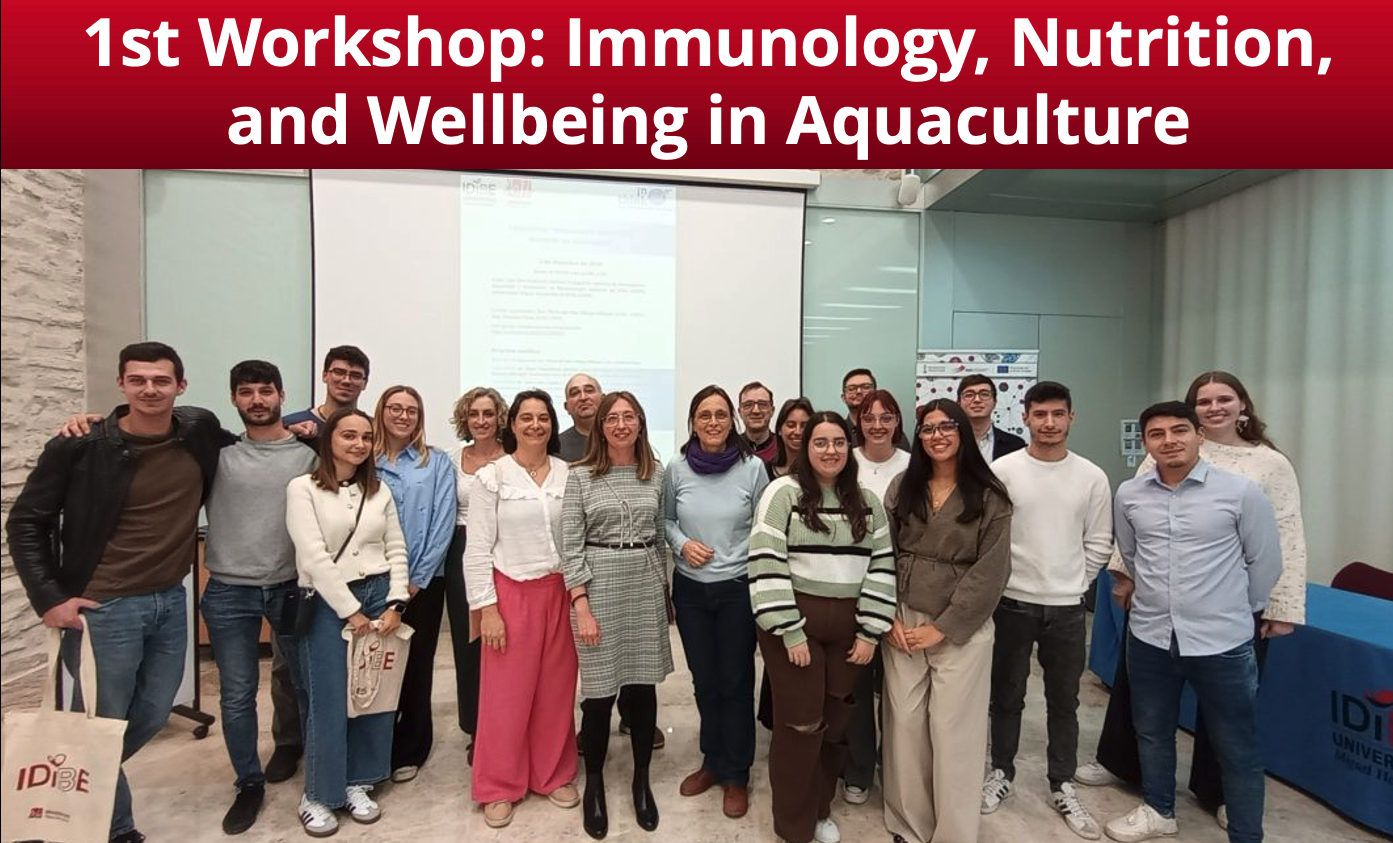RESEARCH
Red Blood Cells in Antiviral Immunology

RESEARCH HIGHLIGHTS
The results obtained from our group have demonstrated that rainbow trout RBCs can respond to viral infections by themselves with an innate immune response, by means of producing antiviral molecules and exerting a paracrine antiviral communication with other cells, and with a potential adaptive immune response, by means of antigen processing and presentation and complement system regulation.Fish immunology and virology.
SCIENTIFIC INTERESTS
Fish are the phylogenetically oldest vertebrate group with an immune system with clear similarities to the immune system of mammals. However, it is an actual matter of fact that the current knowledge of the fish immune system seems to lack the key piece to complete the puzzle.
In 1953 Nelson described a new role of human red blood cells (RBCs) which would go beyond the simple transport of O2 to the tissues. This new role, involved in the defence against microbes, described the antibody and complement-dependent binding of microbial immune complexes to RBCs. Regardless of the importance of this finding in the field of microbial infection, this phenomenon has been poorly evaluated. Just recently, a set of biological processes relevant to immunity have been described in the RBCs of a diverse group of organisms, which include: pathogen recognition, pathogen binding and clearance and cytokines production.
Furthermore, it has been demonstrated that nucleated erythrocytes from fish and avian species develop specific responses to different pathogen associated molecular patterns and produce soluble factors that modulate leukocyte activity.
In the light of these pieces of evidences, and in an attempt to improve the knowledge of the immune mechanism(s) responsible for fish protection against viral infections, we raised the question: could nucleated fish erythrocytes be the key mediators of the antiviral responses? To answer this question we decided to focus our work on the evaluation of the crosstalk between red and white blood cells in the scenario of fish viral infections and prophylaxis. For that we chose a working model composed of the rainbow trout, the viral haemorrhagic septicaemia virus (VHSV) and the glycoprotein G of VHSV (GVHSV), the antigen encoded by this DNA vaccine.
NEWS
MEMBERS
Dr. María del Mar Ortega Villaizán-Romo
Senior Research
Dr. Verónica Chico Gras
Postdoctoral Researcher
Dr. José Carlos Campos Sánchez
Postdoctoral Researcher
Celia García Quintanilla
PhD Student
Maria Salvador Mira
PhD Student
Yeray Kevin Cerpa Damas
PhD Student
Adrian López Murcia
PhD Student
Carla Navarro Quiles
Technical Assistance
FORMER MEMBERS
Dr. Sara Puente Marín
Graduated PhD Student
Dr. Iván Nombela Díaz
Graduated PhD Student
Remedios Torres Montero
Support Personnel
Efrén Lucas Mañogil
Support Personnel
FUNDING
REPRESENTATIVE FUNDING
ERC Starting Grant: https://cordis.europa.eu/project/id/639249/reporting
ERC Proof od Concept: https://cordis.europa.eu/project/id/101069282
REPRESENTATIVE PUBLICATIONS
Salvador-Mira M. et al. (2025)
Eur J Cell Biol. DOI: doi: 10.1016/j.ejcb.2025.151490
Viral vaccines promote endoplasmic reticulum stress-induced unfolding protein response in teleost erythrocytes.
Salvador-Mira M. et al. (2024)
Front Immunol., DOI: doi: 10.3389/fimmu.2024.1466870
Endoplasmic reticulum stress triggers unfolded protein response as an antiviral strategy of teleost erythrocytes
Puente-Marin S. et al. (2023)
Aquaculture, DOI: doi: 10.1016/j.aquaculture.2023.739303
Innate immune response of rainbow trout erythrocytes to spinycterins expressing a downsized viral fragment of viral haemorrhagic septicaemia virus
Ortega-Villaizan MDM, et al. (2022)
Front Immunol., DOI: doi: 10.3389/fimmu.2022.1005546
The role of red blood cells in the immune response of fish
Chico V. et al. (2021)
Biology (Basel), DOI: doi: 10.3390/biology10101045
Antiviral Function of NKEF against VHSV in Rainbow Trout
Salvador-Mira M., et al. (2021)
Int J Mol Sci,, DOI: doi: 10.3390/ijms222111821
Immunomodulatory Lectin-like Peptides for Fish Erythrocytes-Targeting as Potential Antiviral Drug Delivery Platforms
Nombela I. et al. (2019)
Vaccines (Basel), DOI: doi.org/10.3390/vaccines7030063
Integrated Transcriptomic and Proteomic Analysis of Red Blood Cells from Rainbow Trout Challenged with VHSV Point Towards Novel Immunomodulant Targets.
Puente-Marin S., et al. (2019)
Vaccines (Basel), DOI: doi.org/10.3390/vaccines7030060
Potencial Role of Rainbow Trout Erytrocytes as Mediators in the Immune Response Induced by a DNA vaccine in Fish.
puente-marin s., et al. (2019)
Front Immunol., DOI: doi.org/10.3389/fimmu.2019.01055
Fish Red Blood Cells Modulate Immune Genes in Response to Bacterial Inclusion Bodies Made of TNFα and a G-VHSV Fragment.
CHICO, V., et al. (2019)
Front Immunol., DOI: doi.org/10.3389/fimmu.2019.00613
IFIT5 Participates in the Antiviral Mechanisms of Rainbow Trout Red Blood Cells.
NOMBELA I., et al. (2019)
Cells, DOI: doi.org/10.3390/cells8050386
Rainbow Trout Red Blood Cells Exposed to Viral Hemorrhagic Seoticemia Virus Up-Regulate Antigen-Processing Mechanisms and MHC I&II, CD86 and Antigen-presenting Cell Markers.
JUNG MH., et al. (2019)
Front Immunol., DOI: doi.org/10.3389/fimmu.2019.00160
The Megalocytivirus RBIV Induces Apoptosis and MHC Class I Presentation in Rock Bream (Oplegnathus fasciatus) Red Blood Cells.
CHICO V., et al. (2018)
IntechOpen, DOI: 10.5772/intechopen.80545
Nucleated Red Blood Cells Contribute to the Host Immune Response Against Pathogens, Immune Response Activation and Immunomodulation.
Puente-Marin S., et al. (2018)
Genes, DOI: doi.org/10.3390/genes9040202
In silico functional networks identified in fish nucleated red blood cells by means of transcriptomic and proteomic profiling
Chico V., et al. (2018)
Cells, DOI: 10.3390/cells7040031
Shape-shifted red blood cells: a novel red blood cell stage? .
nombela i. and ortega-villaizan M. M. (2018)
PLOS Pathogens, DOI: 10.1371/journal.ppat.1006910
Nucleated red blood cells: Immune cell mediators of the antiviral response.








